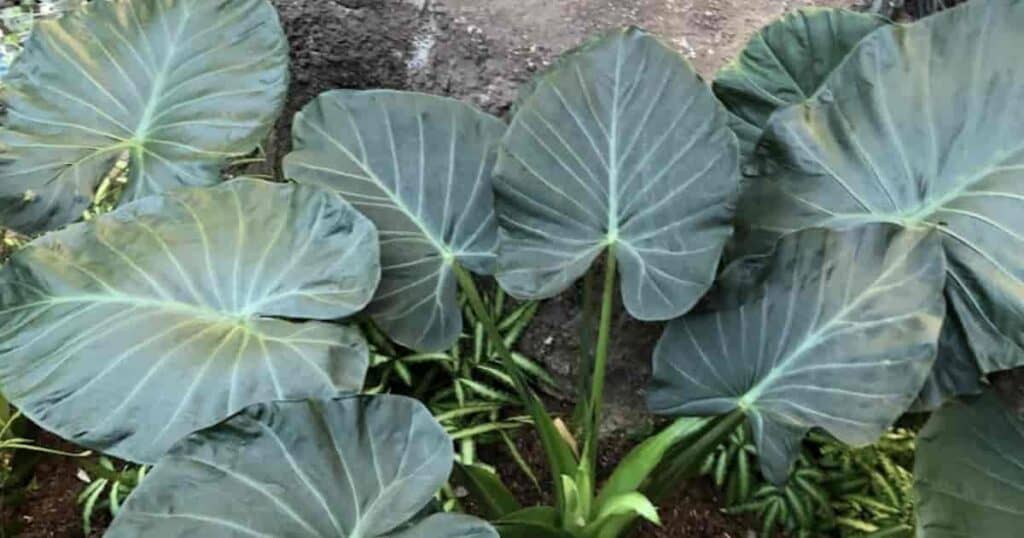In the wonderful world of houseplants, there are two major categories of plants: those grown for their blooms and those grown for their foliage. A great example of the latter is the elephant ear plant, so named because its leaves are large and resemble an elephant’s ears.
However, the name “elephant ear plant” doesn’t apply to just one plant or genus. Instead, five different genera all bear this name, making caring for these plants rather complicated if you don’t know what you have.
One essential aspect of growing any houseplant is whether or not it’s toxic to humans or pets. But this can become a very complicated question regarding the elephant ear plant.
Here are the basics of what you need to know to determine if your plant is toxic or not.
Which Elephant Ear Plant Do You Own?
Before we can get into toxicity, let’s take a moment to try and figure out what kind of elephant ear plant you own.
The following descriptions are general, so if you’re in doubt, please use a reputable plant identification app or consult an expert.
Never consume plants you haven’t identified, and always treat accidental consumption of an unidentified plant as possible poisoning.
Alocasias
Alocasia plants are medium-sized elephant ear plants, ranging from 2′ to 6’ feet tall, and leaves that range from 8″ to 35” inches long.
They have long petioles and leaf shapes ranging from heart-shaped to oval, always with pointed tips.
Caladiums
The seven Caladium species and more than 1,000 cultivars that make up this genus are among the smaller elephant ear plants.
They typically range from 15″ to 35” inches tall and have rounded to oval leaves measuring 6″ to 18” inches long.
Colocasias
Perhaps the most popular among the elephant ears is the Colocasia, which grows 3′ to 6’ feet tall with massive 8″ to 59” inch long leaves.
The leaves are roughly shield-shaped, and members of this South Asian genus are grown worldwide.
Xanthosomas
This genus isn’t as widely known as Colocasias, but they put the latter to shame.
Their arrowhead-shaped leaves measure a colossal 16″ to 79” inches long, making this south-to-central American plant stand out wherever it’s planted.
Is the Elephant Ear Plant Poisonous Or Toxic?
The answer to this largely depends on what genus your elephant ear plant belongs to. Some are toxic, while others are edible, and some are even food staples.
Toxicity Of Various Elephant Ear Plants
Now that you have a basic idea of how these plants can be told apart, it’s time to look at their toxicity towards humans.
All four of these genera are closely related and contain calcium oxalate crystals. This substance can cause mouth and throat irritation and majorly cause kidney stones when consumed in large quantities.
The effects on children are more severe than on adults, although symptoms are rarely serious enough to be life-threatening.
Of the four genera, caladiums pose the highest risk, and even their sap is an irritant.
Alocasias need to be properly prepared to neutralize the crystals, but some species are considered to have edible corms once processed.
Colocasias are a food staple in many parts of the world, as are xanthosomas, and can be found in many popular cuisines.
In fact, colocasias are used to make poi, one of the most famous dishes in Hawai’ian cuisine.
Incidentally, the common name for Colocasia esculenta is taro, and you’ve likely already consumed the root at some point in your life.
Elephant Ear Toxicity To Pets
This is where the blur ends, and we have a single answer for all four genera.
Due to the amount of calcium oxalate, these plants are ALL toxic to cats and dogs.
In fact, consumption can make dogs very ill, with vomiting, diarrhea, mouth irritation, lethargy, and many other symptoms arising.
For cats, which are much smaller, consumption may prove fatal.
Thus, while it’s important to consult with a doctor if you or a two-legged family member has attempted to consume an elephant ear plant, it’s absolutely essential to contact your vet if you believe a four-legged member of your family has tried to eat these plants.






